|
Monday, January 10, 2011
Progress Notes
David Eli Bear (photo 01), who was my uncle, brother to my mother, passed away last month at the age of 93.
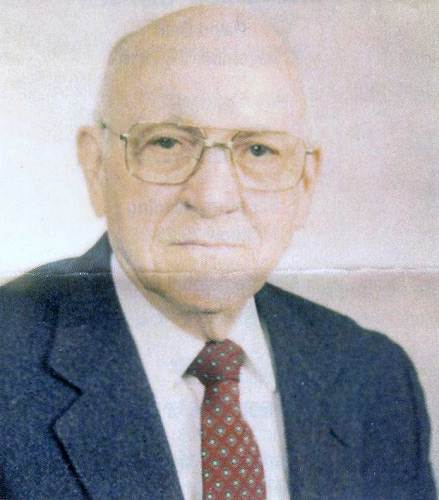
01 David Eli Bear - 1917-2010 He was born on the original Bear family farm on Dog Creek south of the Osage River in 1917 (photos 02 and 03).
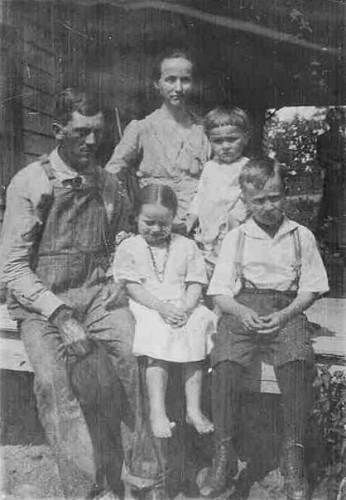
02 David Eli Bear (standing) and Family on Farm - circa 1918
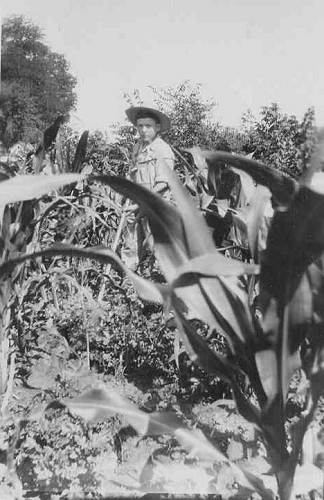
03 David Bear on Farm At the age of 5 his parents (Madison and Sadie Abbett Bear) moved to Tuscumbia where they managed the Farmer’s Exchange store (photo 04).
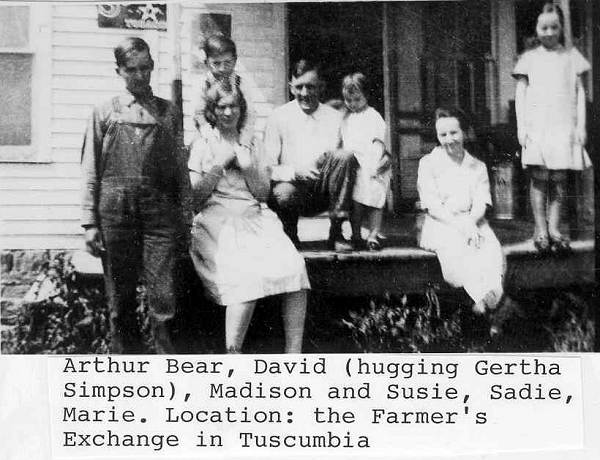
04 Farmer's Exchange Store - Tuscumbia Later, Madison established a general store in the Woodman Fellow Hall building located next to the Exchange store where David worked part time to help his father (photos 05 and 06).
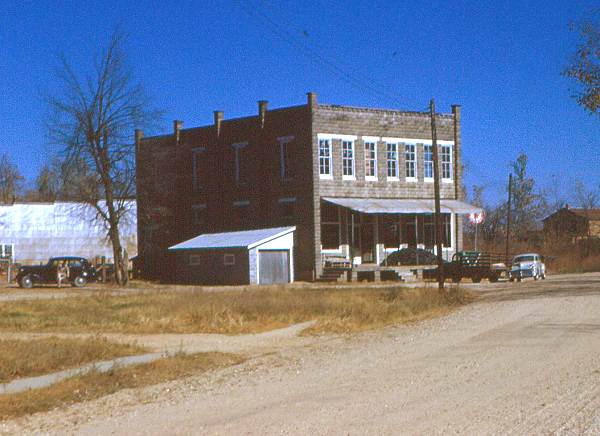
05 Madison Bear's General Store in Old Woodman Hall Building
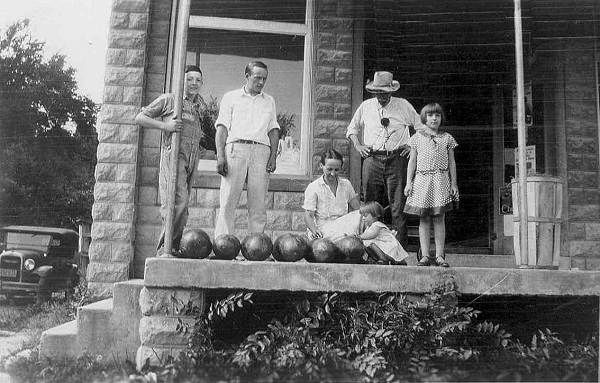
06 Front Porch Store in Tuscumbia - David, Arthur, Sadie, Bonnie, David C. Bear and Susie (I discussed the historic Woodman Fellow Hall building in last week’s Progress Notes.)
When the Bagnell Dam was being built David’s father, Madison, established a store in Bagnell where David also sometimes worked as a boy (photo 07).
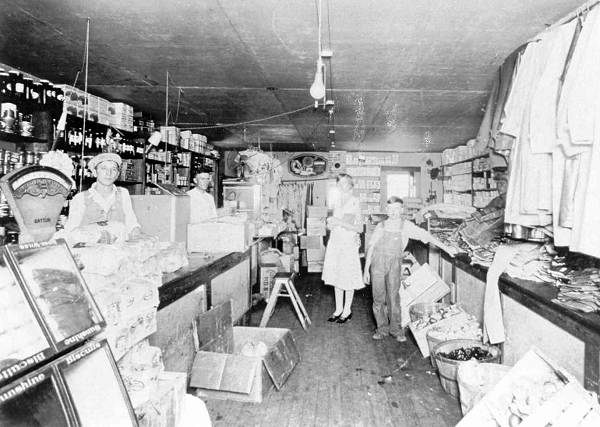
07 Bear Store in Bagnell - Frank Martin, Madison Bear and Davd Bear As a young boy David attended school in Tuscumbia. One of his classmates and good friend at Tuscumbia High School was Royal Kallenbach.
Later David attended Iberia Junior College following which he taught school for awhile before going overseas during WWII to serve three years in Italy.
Upon returning home he moved to Alton, Illinois where his sister and brother in law, Robert and Marie (Bear) Stillwell lived, both also originally from Tuscumbia. It was there David met his life long wife, Myra Bonnell (photo 08).
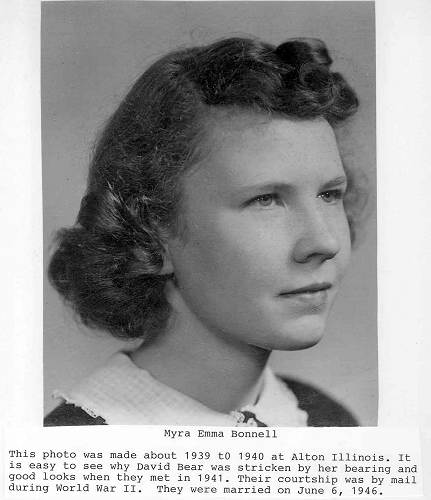
08 Myra Emma Bonnell Bear
Click image for larger viewDuring this time David continued his education eventually earning a PhD in Education from Washington University in St. Louis. He spent his life in an academic career as an educator in Alton, Illinois.
Here is an article from the local Alton paper which details his life there:
Former School Board President David Bear Dead at 93
December 6, 2010
By Linda N. Weller
The Telegraph
Alton…A longtime educator and Alton School Board president who led the district through tight financial times in the early 1970’s died Saturday.
David Eli Bear, 93, of Godfrey, Illinois, professor emeritus at Southern Illinois University, died at Alton, Illinois Memorial Hospital.
“He was a very impressive gentleman; he was extra intelligent and had a lot of class,” Alton School District Superintendent David Elson said. The board hired Elson as a teacher in 1970, when Bear was president.
“I remember seeing his name on my contract and on my paycheck,” Elson said. He said the board consisted of prominent community leaders, including Bear.
“They were really revered, highly respected and looked up to,” Elson said.
Similar to today’s tight finances, the 1970 era school district also had money problems that forced the board, under Bear’s leadership, to have to lay off staff.
“They met at Haskell House and read off the names of the teachers they were laying off,” Elson said, with a crowd of educators pouring outside from the building during the meeting.”
“They had some real financial issues then, “Elson said.
Telegraph clippings also said the board had to deal with overcrowding from the burgeoning baby boomer population and correct deficiencies noted by the North Central Association on Accreditation.
Bear served on the board from 1960 to 1973, and was president from 1970 to 1972.
When he was elected in April 1960, a Telegraph editorial called him and fellow electee Horace Dale “top School Board choices.”
“Dr. Bear, well acquainted with Alton and its problems, will bring a professional educator’s view to the board,” it said. “Of particular value will be his college level approach to the need for public schools to concentrate at least certain portions of their programs toward better preparing their products for the ever increasing competition for college and university acceptance.”
Bear was born in Tuscumbia, Mo., on November 27, 1917, and graduated from Iberia Junior College in Iberia, Missouri in 1938. He earned a bachelor’s degree from Springfield State Teachers College in Missouri in 1941, now Missouri State University, and earned a doctorate of education from Washington University in St. Louis in 1958.
An elementary education specialist, he taught in Bloodland, Missouri, served in the U.S. Army from 1942 to 1945, working in a medical department, then taught at the elementary level in Wood River from 1947 to 1949.
He was hired as a principal in the Alton School District in 1949, where he worked until 1957. He then was one of the first instructors hired in 1957 at the new, Southern Illinois University’s Alton residence Center.
Bear taught reading education at SIU and headed its Education Division. He retired from the Department of Curriculum and Instruction in the university’s School of Education in 1978, after relocating to the Edwardsville campus.
A number of Bear’s relatives also are educators, and his sister, Bonnie Tyler, also served on the Alton School Board.
Among his memberships were Upper Alton Baptist Church, Franklin Masonic Lodge and Phi Delta Kappa.
Bear is survived by his widow, Myra, whom he married in June 1946; sons Philip, Stephen and John; 12 grandchildren and three great grandchildren.
A memorial service is scheduled for 11 a.m. Tuesday, December 21, at Upper Alton Baptist Church, 2726 College Avenue, Alton, Illinois.
Copied here is the official obituary of David E. Bear:
12/8/10
David E. Bear; Was Professor Emeritus in the SIUE School of Education
David Eli Bear, of Godfrey, professor emeritus in the Southern Illinois University Edwardsville School of Education and a pioneer educator at the University, died Dec. 4 at Alton Memorial Hospital. He was 93.
Retired from the Department of Curriculum and Instruction in 1978, Bear joined the faculty of Southern Illinois University in 1957 and served for many years as the chair of the SIUE Department of Elementary Education, pushing the school to take a more active role with education in the Metro East "in areas where the need is greatest," according to SIUE University News Service archives.
Born in Tuscumbia, Mo., Bear graduated from Iberia (MO) Junior College in 1938. He earned a bachelor's at Springfield State Teachers College in Missouri in 1941, now Missouri State University; and earned a doctorate of education from Washington University in St. Louis in 1958.
Through the years, Bear served in various leadership capacities in organizations including the National Education Association, the Illinois Education Association, the Association for Supervision and Curriculum Development, Phi Delta Kappa Education Fraternity and the Illinois Elementary Principals Association. He also was elected treasurer and president of the Illinois Reading Council.
Before coming to SIUE, he was a principal in the Alton School District. He also was a member of the Alton School Board in the 1970s, helping the district through difficult financial times.
A memorial service is scheduled for 11 a.m. Tuesday, Dec. 21, at Upper Alton Baptist Church, 2726 College Ave.
David was an historian who wrote a significant number of articles about Tuscumbia history, many of which I have placed on previous Progress Notes. In particular, regular readers may remember the series of articles about Tuscumbia history that David and his brother, Arthur Bear, recorded which was transcribed and placed on the website over a number of months in 2008 (photo 09).
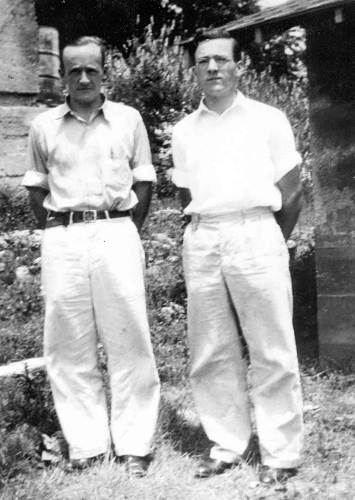
09 Arthur and David Bear David also wrote the Bear family history which you can read under the biography section of our website.
I communicated often by telephone with David regarding historical events of Miller County, especially those of early Tuscumbia and the surrounding rural area. He had an excellent memory of encyclopedic nature. I always enjoyed being with him because he was one of those from whom one can always learn something. David became ill about a year ago; his diagnosis at death was metastatic cancer, etiology unknown. One of the last times I was with him for any length of time was in 2008 at a wedding of one of his granddaughters. Here is a photo of both of us at that event (photo 10):
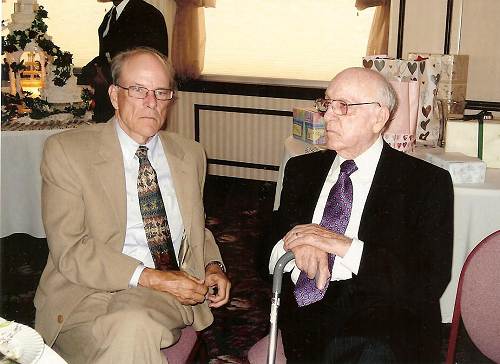
10 Joe Pryor and David Bear - 2008 Although David was a prolific writer who wrote quite a number of articles about his memories of Tuscumbia, one of his especially interesting essays was about his experience in Italy during WWII. This essay also included a number of photos of the area where he was stationed. So in honor of David’s service during the war I thought I would present the essay for this week’s Progress Notes (photo 10a):
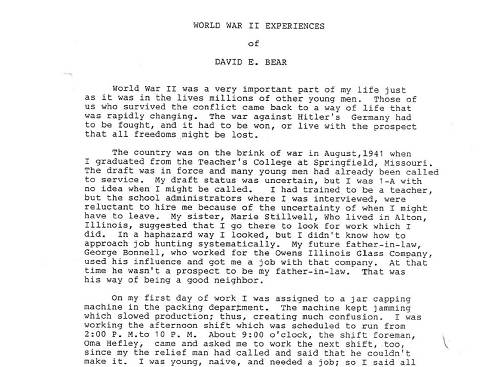
10a David Bear's WWII Narrative
Click image to read the entire narrative in PDF formatThe following is a collage of photos taken by David in Italy (photos 11 - 20):
Click on any of the thumbnails to view a larger image.
Note: Once you click on an image below, a new window will open. It would be best to maximize this new window by clicking on the middle box in the upper right-hand corner of the window. When you move your cursor over the image in this new window, it will change to a magnifying glass. Once this occurs, click on the image and it will show in a larger format for easier viewing.
As a follow up to David Bear’s personal experiences during WWII I thought this week would be an appropriate time to present a narrative historian Gerard Schultz wrote concerning the State of Missouri’s contribution to the war effort in WWII. This is a long article without photos since it is mostly filled with data and factual material. However, Gerard has put together an extraordinarily well-researched effort that presents information we never would have known were it not for his interest in the subject. Gerard, as many readers remember, was a professor at the Iberia Academy for several years in the 1930’s.
MISSOURI AND THE WAR
PART XVI
HOME FRONT IN RURAL MISSOURI
DURING WORLD WAR II
BY GERARD SCHULTZ (photo 21)
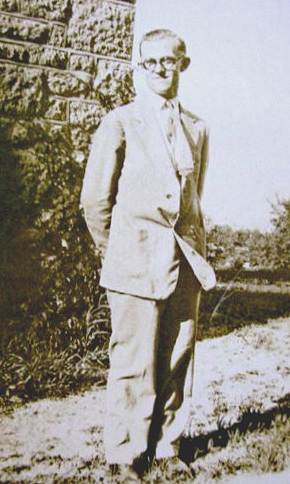
21 Gerard Schultz Introduction:
GERARD SCHULTZ, a native Missourian, received an A.B. degree from Knox College, Galesburg, Illinois, in 1925, and an A.M. degree from the University of Minnesota in 1928. He was a teaching fellow at the latter institution in 1925 and 1927, instructor in the University of Missouri summer sessions at Rolla, instructor at Iberia Junior College, 1926, 1928-1944, and is at present instructor in rural sociology in the University of Missouri at Columbia. He has published articles and books, including A History of Miller County, Missouri, and Early History of the Northern Ozarks.
The data for this article was collected during his research for the Agricultural Extension Division of the University of Missouri, 1944-1945. A research bulletin by him for that division, "Some Effects of World War II on Rural Life in Missouri," is now in press.
Successive major wars of modern history have affected an ever increasing number of people. Modern war demands that the armed forces fight, but to have any chance to win over the enemy, civilians must supply them with vast quantities of war matériel. The urgent demands of World War II brought many changes, such as those in population, in agricultural and mineral production, and in governmental control and regulation; Missouri is no exception to this rule.
In 1914 the rural population of the State received the news of the beginning of World War I ''almost incredulously, much as if it came from another world." Many looked upon that war as an explosion that seemingly lay entirely outside of the United States. By 1939, however, modern communication had done much to break down the isolation of rural localities. In 1939 the rural classes listened to the radio in their homes, stores, garages, and other places of business to hear the war news broadcasts from London, Paris, Berlin, and Warsaw. Although some rural editors insisted firmly against American participation in the war, the prevailing belief was that the United States would finally be drawn into the conflict.
The Japanese attack on Pearl Harbor on December 7, 1941, had a unifying effect never before experienced in a war that involved the State. The editor of a country weekly in a rural county in Missouri with a large percentage of its population of German origin wrote in the issue of his newspaper on December 11, 1941:
Expressions of loyalty to the President and hatred for the Japanese and Hitler are heard on every hand here . . . while there seemed to be some difference of opinion before the outbreak of hostilities as to the government's foreign policy, the Jap attack has apparently served only to unite everybody in the common aim to win the war, no matter what the cost.
President Franklin D. Roosevelt's message to Congress on
December 8 of the same week was given a prominent place on the front page of the newspaper. Two weeks later the editor reported that the "people are listening to war reports and talking about them these days to the exclusion of almost everything else, Christmas included."
With the unexpected collapse of France early in the summer of 1940, the national defense program of the United States began in earnest. The building of ships, army posts, naval bases, and factories for the production of war materiel brought a continuously growing demand for workers, with the result that thousands of families or individual members of families migrated from Missouri farms and villages to centers of defense industries. In this migration the number of persons who left the state exceeded the number who entered it. The estimated net loss in the population of the state as a result of civilian migration during the three and one-half years between April 1, 1940, and November 1, 1943, was 116,916.
This figure was obtained by adding the natural increase for the period, 112,101, to the civilian population as of April 1, 1940, 3,783,666, and then subtracting the net loss to the armed forces up to November 1, 1943, 256,836.
Since the resulting figure is larger than the 1943 civilian population, which was 3,524,790, as estimated by the number of ration book registrations on November
1, 1943, it is estimated that the out-migration amounted to the difference, 258,876.
The best available estimates of population changes since 1940 are obtained from the Bureau of the Census, and are based on the number of sugar and food sales.
The distribution of the population within the state also underwent changes. During the period from April 1, 1940, to November 1, 1943, seven counties and the city of St. Louis gained in civilian population. Four of these counties—St. Louis, St. Charles, Jackson, and Clay—were large centers of war industries. In two counties, Phelps and Pulaski, the increase was due to the employment and business opportunities created by the building of Fort Leonard Wood. Mississippi County, which experienced only a small increase in the civilian population, is located in an expanding agricultural area in which the population was growing rapidly prior to the war. In 107 counties the civilian population declined, of which in 92 the loss exceeded ten percent of the prewar population.
The heaviest losses occurred in the Ozark region where ten counties had losses in excess of 25 percent.
In 1920, when the United States Census showed the farm population separately for the first time, the farm population of Missouri was 1,207,899. By 1930 the farm population had declined to 1,108,969, but as a result of the serious industrial depression during the early 1930's, it increased to 1,183,499 as of January 1, 1935.
However, after 1935 the general downward trend in the size of the farm population of Missouri continued, reaching 1,118,644 in 1940.
During the war the farm population of the State fell to approximately a million.
The total civilian loss between April 1, 1940, and March 1,
1943, was 207,932, or a loss of 5.5 percent.
The decrease in the farm population was largely a result of inductions into the armed forces and also a result of migration from farms to areas of war activity.
The military draft also brought a heavy impact upon the rural population. On September 16, 1940, Congress passed the Selective Service and Training Act. Within a month all preparations for the first registration were completed, and on October 16, 1940, 446,219 men in Missouri between the ages of 21 and 35, inclusive, registered for possible military service.
Within a month after registration, local Selective
Service boards started the first men on their way to the army.
Four other registration days were announced—July 1, 1941, for men who had reached the age of 21 since the first registration; February 16, 1942, for men between the ages of 20 and 44, inclusive, who had not been listed previously; April 27, 1942, for men between the ages of 45 and 65 for non-military service; and June 30, 1942, for men between 18 and 20, inclusive.
Those reaching 18 during the six months from June
30 to December 31, 1942, registered between December 11-31, 1942.
At the end of 1942 Missouri had a total of 784,424 living registrants for military service. Those reaching 18 after December 31, 1942, registered as they attained that age. As
a result of inductions in the armed forces and also as a result of migration to areas of war activity, Missouri farms during the war were operated largely by men over 35 years of age, by women, and by youths under 18.
A number of important centers of war activity were established in the rural areas of the state. The construction of the Weldon Springs Ordinance Works for the manufacture of TNT and DNT near Weldon Springs in St. Charles County was announced in October, 1940. By March, 1941, there were over 1,200 men working in constructing the plant, and by the following November the number had increased to 8,699.
In November, 1940, the War Department announced its intention to build a large army training post in the Missouri Ozarks near the small and leisurely town of Waynesville. Construction of Fort Leonard Wood got underway almost immediately. Workers poured into the area by the thousands and by the end of March the weekly payroll for the construction of the fort was reported to be $1,380,000. The construction of Camp Crowder near Neosho was begun in August, 1941.
The peak of employment was reached the week of December 20, 1941, when 21,034 were employed and the weekly payroll amounted to $650,000.
In time of war, farms must supply more food as well as many of the raw materials needed in the production of war materiel. To meet these needs, Missouri farmers greatly increased agricultural production reaching its wartime peak in 1944. Both in acreage planted and in crop value, corn is the leading crop in the state. In 1939, 126,290,000 bushels of corn were harvested from 4,281,000 acres. In 1944, 162,554,000 bushels of corn were harvested from 4,781,000 acres.
A tremendous gain was made during the war in the production of beef and pork. The number of cattle marketed in 1944 was 1,520,994 as compared to 812,587 in 1939. The number of hogs marketed in 1944 was 5,623,309 as compared to 3,456,607 in 1939. To supply the war demand for vegetable oil and protein, the production of soybeans was pushed from 1,157,000 bushels in 1939 to 10,605,000 bushels in 1944. These and other increases were partly offset by decreases in wheat, oats, barley, and cotton.
As a result of higher farm prices and greater agricultural production, the total farm income in Missouri increased from $253,333,000 in 1939 to $682,923,000 in 1944. In general, in 1944 the total value of all corn produced in Missouri was $173,933,000.
Hay was the second most valuable crop, the value of all tame hay raised in the state that year being $57,785,000.
Missouri. The above figures do not include governmental payments which amounted to $28,132,000 in 1939 and $25,159,000 in 1944.
Farm prices were more than twice as high in 1944 as in 1939. The changes in the prices of the leading crops of the state for the two comparative years are shown in the following table:
Avg. Price Avg. Price
1939 1944
Corn (bu.) $0.54 $1.10
Wheat (bu.) 0.67 1.47
Oats (bu.) 0.28 0.79
Soybeans (bu.) 0.85 2.05
Cotton lint (lb.) 0.08 0.21
Tame hay (ton) 5.70 16.60
During the war the average price of Missouri farm land increased by approximately one-half compared to the average for the years from 1935 to 1939.24.
The large increase in agricultural production during the war was achieved in spite of acute shortages of farm labor and farm machinery. The farm labor shortage was overcome chiefly by farmers' working longer hours, by neighborhood exchanges of labor and farm machines, by using labor saving devices, and by an increase in the number of family workers.
The work that produced the best results in helping with the labor program was the encouragement of making labor-saving machinery and trading of work in different communities. Ten large power bull rakes were made that helped very much with threshing out of shocks and making hay. They were used on many more than the ten farms where they were purchased. . . . Two of these bull rakes would keep a large threshing machine in operation. Two men with one bull rake could bring in twice as much hay in a day as three men could bring in with a wagon and hay loader.
New mechanical corn pickers did much to relieve the labor shortage at the time of the corn harvest in northwest Missouri. A two-row corn picker with a crew of four men harvested an average of 1,000 bushels of corn per day.
When corn is gathered by hand, a very good cornshucker is able to harvest about 100 bushels in a long hard day. A total of 3,600 corn pickers were used on Missouri farms in the fall of 1944.
As a result of the shortage of hired farm workers, more of the farm work throughout the state was done by the farm family. For example, on one farm a farmer's thirteen-year old son operated the tractor, his fifteen-year-old daughter operated the binder, and his wife and another daughter shocked the oats crop, while the farmer himself combined the wheat.
In 1943 many business and professional men in small towns helped farmers in harvesting their crops, but this kind of farm help was far less prevalent during the last two years of war.
Prisoners of war were also used to help relieve the farm labor shortage. In 1945, 4,976 prisoners of war worked on Missouri farms.
The recruitment of full-time and seasonal laborers to supply the needs of Missouri farmers was the responsibility of the Farm Security Administration up to the spring of 1943 when it was transferred to the Agricultural Extension Service.
Most of the requests for year-round farm labor came from north Missouri, while the supply was found chiefly in the Ozark counties. The total number of farm labor placements made by the Extension Service in 1944 was 21,024. Of these, 2,407 were for year-round work, while the others were for periods extending from one day to five months.
During the war farm wages in Missouri rose sharply. The monthly wage of the hired farm laborer with board rose from $22.75 in April, 1940, to $63.00 in April, 1945. During the same period the monthly wage without board rose from $31.50 to $82.00.
The daily wage with board increased from $1.10 to $3.10, while the daily wage without board increased from $1.40 to $3.80 from April, 1940, to April, 1945.
A number of minerals produced in Missouri played important roles in the war. The refractory clays were in great demand for bricks, linings of boilers and furnaces, and the building of Liberty and other cargo vessels. In 1943 Missouri ranked first among the states in the production of fire clay and was the only producer of diaspore and burley clays. During the war southeast Missouri continued to be the largest lead producing area in the United States, supplying 257,145 tons, or 39 percent of the nation's total lead output in 1943. The demand for zinc ore far exceeded its production. The federal government paid subsidies on both lead and zinc in order for the lower grade ores to be mined also. A sharp increase occurred in the demand for coal as many war plants had to convert from the burning of natural gas to the use of coal for fuel and power. The dollar value of mineral production in Missouri increased from $51,872,163 in 1939 to $90,993,119 in 1943.
During the war important new developments and changes occurred in mining operations: open pit methods of mining lead and zinc were introduced in the Joplin district; new properties of low grade ores in the state were developed and operated; old mines which had been abandoned were reopened and put into production. Iron Mountain in southeastern Missouri was reopened as an open pit mine. Stripping equipment was used extensively to open new coal mines. Shales in the Kansas City area were mined for use in the construction of concrete barges.
The wartime demand for barite, probably better known as "tiff," resulted in mechanization of the Washington County barite area. In 1945 it was reported that 700 workers with mechanized mining equipment produced more barite than was mined a few years ago by 3,500 diggers, including women and children who worked in family groups.
Lumbering also experienced a remarkable increase during the war. In the period immediately preceding the war the annual output of Missouri sawmills was approximately 100,000,000 board feet. In 1944 the output was about 335,000,000 board feet. There was also an increase in the cutting of trees for pulpwood. Cottonwood trees growing in the alluvial soil along the Missouri and Mississippi rivers were commonly used for this purpose.
No survey of the home front in rural Missouri would be satisfactory without some mention of the activities of special war agencies and the regular agencies that aided the war effort. USDA defense boards, later known as USDA war boards, were set up in the summer of 1941 to consolidate and strengthen the farm programs for wartime tasks. Secretary of Agriculture Claude R. Wickard appointed C. W. Sheppard, then chairman of the State AAA Committee, head of the USDA defense boards in Missouri. The boards assisted farmers in setting farm production goals, in rationing new farm machinery, and in making recommendations with respect to Selective Service deferments for farm boys.
The Agricultural Extension Service, with J. W. Burch as director, carried forward a general wartime educational program in agriculture and home economics. Greater emphasis was placed on the production, the preservation, and the utilization of food and feed, the maintenance of health and well-being, and the conservation of farm and home supplies and equipment. An important development in vocational education in the rural field was the establishment of school canneries, introduced and supervised by teachers of vocational agriculture and vocational home economics during the summer of 1943. By 1944, 128 canning centers had been established, 82 of which were equipped with steam retorts and power.
In spite of shortages of labor and machinery, soil conservation practices were expanded by the Soil Conservation Service during the war. The practice of liming for soil improvement increased almost five-fold. A large increase also occurred in the tonnage of commercial fertilizer used on farms. Methods of conserving and protecting the soil, such as terracing and contouring, were extended. On the other hand, the pressure of war demands led to an increase of certain crops in areas where it was not in the best interests of soil conservation to increase them.
The Rural Electrification Administration made its first allotment of loan funds for rural electrification in Missouri in July, 1936, but it was not until August 1, 1937, that the Lewis County Cooperative Rural Electric Association energized 105 miles of line in northeast Missouri, marking the beginning of REA distribution of electricity in the state. By June 30, 1944, REA loans had been made to thirty-nine locally controlled electric-service cooperatives and to one private utility. By that time 64,700 farms in the state received central-station current as compared to 17,893 in 1935. Fifty-seven percent of the farms receiving central-station current in 1944 were served by the Rural Electrification Administration. The shortage of labor on farms and the higher farm incomes incident to the war greatly increased the demand for electric service. The War Production Board, recognizing the importance of electricity on the farm in the production of war-needed foods, permitted the use of small amounts of scarce materials and manpower for the extension of electric lines to qualified farms.
An act of the General Assembly, approved July 2, 1941, provided for the establishment of a state council of defense.
In accordance with this act, Governor Forrest C. Donnell issued a proclamation, October 9, 1941, creating the Missouri State Council of Defense. Hugh Stephens of Jefferson City served as administrator of the Council from October 9, 1941, until July 6, 1943, when he was succeeded by James A. Potter, also of Jefferson City. County councils of defense were organized during the winter of 1941-1942,43 and by July, 1942, 400,000 volunteers had enrolled for civilian defense work.
The emphasis of civilian defense in World War II was on protection for the civilian population. A state-wide trial blackout was successfully carried out on the evening of December 9, 1942, but when the threat of enemy bombers in the sky gradually vanished, interest in many defense activities declined. A number of communities entirely disregarded the second statewide trial blackout held August 31, 1943.
Adequate supplies of certain waste materials were of great importance in the manufacture of war material. Scrap iron was needed to produce a high grade of steel for the implements of war which had to be manufactured in huge quantities. A number of special drives was held to stimulate the flow of scrap iron, rubber, paper, and other waste materials into regular commercial channels. Missouri farmers rounded up a huge quantity of scrap iron and metals. Not only were the tremendous demands of production met, but a considerable backlog was built up. Rural areas also responded splendidly in the national drive for the collection of scrap rubber during the summer of 1942. For example, 240,597 pounds of scrap rubber had been collected in a drive in Harrison County concluded July 10, 1942.
The State and County Councils of Defense helped to promote salvage drives. Soon after the American entry into the war, a rationing program was inaugurated in an effort to control living costs and to provide for a fair distribution of certain scarce articles available for civilian use. Late in December, 1941, state authorities were informed that rationing of automobile tires would begin on January 5, 1942. The State and County Councils of Defense assumed responsibility for organizing rationing boards. James A. Potter of Jefferson City served as State Rationing Administrator until the rationing boards were placed under the control of the Office of Price Administration during the summer of 1943. The rationing of gasoline for motor vehicles began in Missouri on December 1, 1942.
Rationing of tires and gasoline led to a sharp decline in automobile traffic. Since 1934, the Missouri State Highway
Commission has taken state-wide and comprehensive censuses of traffic on the roads of the state highway system. During the years preceding the American entry into World War II, traffic on Missouri highways steadily increased. The first year of tire rationing, automobile passenger car traffic declined about 25 percent. In 1943, the first year of gasoline rationing, traffic declined to 54 percent of the average for 1941; however, the decline was less on the supplementary than on the major highways. The use of small trucks on the supplementary roads in 1943 averaged about 75 percent of what it had been in 1941.
To help finance the war and to help maintain the economic stability of the country, the War Finance Division was established in the Treasury Department of the United States. The chief function of this new agency was to sell war bonds and stamps to corporations, to partnerships, and to every individual with an income. While war bonds and stamps were sold on a month-to-month basis, eight special drives were held.
Quotas were set for various area units in all of these drives, except the first. Of the 114 counties in the state, 97 raised their quotas in the second drive, 96 in the third, 111 in the fourth, 109 in the fifth, 110 in the sixth, and all counties oversubscribed their quotas in the seventh and eighth.
The State oversubscribed its quota in each war loan drive as follows:
Amount Quota Subscribed
First drive $215,398,877
Second drive $159,726,000 $277,075,704
Third drive 320,000,000 372,939,755
Fourth drive 282,000,000 359,715,878
Fifth drive 315,000,000 447,646,529
Sixth drive 276,000,000 422,783,496
Seventh drive 280,000,000 562,962,511
Eighth drive 205,000,000 456,069,020
The total amount subscribed in these eight war loan drives was $3,114,591,770, of which $555,750,781 was subscribed by the counties, exclusive of the city of St. Louis, and St. Louis and Jackson counties.
Rural school children and teachers made noteworthy
contributions to the war effort by purchasing war stamps and bonds and collecting large quantities of scrap iron, metals, rubber, and paper, ransacking attics, garages and cellars, and scouring the countryside for these salvage items. The Moore School, a one-room rural school, in Linn County, Missouri, with the cooperation of the people of that county, won first place in a national scrap paper collection contest. The school was credited with the collection of 137 tons of scrap paper.
Among rural institutions, few were affected by the war as much as the elementary school. Although the rural school population has been declining for a number of years, this decline was greatly accelerated by the heavy migration from rural to urban centers during the war. The number of school children enumerated in the rural districts decreased from 268,482 in the school year, 1939-1940, to 240,385 in 1943-1944, or a decrease of 10.4 percent. During the same period the average daily attendance in rural elementary schools declined from144,885,55 to 109,049, a decline of 24.7 percent.
As a result of the acceleration of this trend, the number of low-attendance schools, i. e., the elementary schools with an average daily attendance of less than 15, increased from 3,901 to 5,184 from the school year of 1939-1940 to that of 1942-1943.
During the latter year the low-attendance schools comprised about two-thirds of all the rural elementary schools in the state.
As a result of a war-scarcity of teachers, many of the rural school districts closed their schoolhouses. In 1944-1945 there were 1,677 districts in which rural schoolhouses were closed; of these, fifteen had no pupils and the others transported their pupils elsewhere, usually to schools in town. A large number of male teachers entered the armed forces and women teachers joined various branches of the services for women, while many others, both men and women, left the schools for better paid jobs in war industries. The number of male teachers in rural elementary schools fell from 1,816 in the school year of 1940-1941 to 584, 1943-1944, a decline of 67 percent. The number of teachers who had no training beyond high school increased from 317 in 1939 to 1,093 in 1944.
This brief survey of the home front in rural Missouri during World War II shows that the rural population responded to the demands of the crises in a highly satisfactory manner.
What Missouri produced on its farms and extracted from its mines were important contributions to the war effort of the
United States and the United Nations, and conversely, the impact of the war changed rural life in the state in many ways, of which many will undoubtedly be far-reaching in their influence. Out of the experience of the war comes the challenge to maintain in the postwar period the productive capacity and the cooperative effort developed during the war and to divert it from destructive to constructive purposes.
Dan Peek recently was in Cape Girardeau to give a book signing for the book he wrote, “Live! The Ozark Opry,” where he was interviewed by a reporter for the Southeast Missourian newspaper.
Thanks to my website manager, David Statler, for locating the article and sending it to me.
Last week Judy and I attended Lake of the Ozarks Eagle Days which has become over the last few years one of the more popular events during the winter for the Lake area. The program was sponsored by the Lake Area Chamber of Commerce, Lake of the Ozarks Convention and Visitor Bureau along with Osage National Golf Resort. Live eagles from the World Bird Sanctuary located in St. Louis were on display for the program at Osage National where lectures were given periodically during the day (photos 24 and 25).

24 Sanibel from the World Bird Sanctuary

25 Sanibel on Tour Souvenirs were for sale from which the proceeds were distributed to the World Bird Santuary (photos 26 and 27).

26 Bald Eagle Souvenirs

27 Bald Eagle Wood Carvings In addition, trips on the paddle wheeler Tom Sawyer were offered to transport guests to locations of eagle nests located in trees along the bluffs. Wilmore Lodge also had a display and educational program. Below the dam was located a tent sponsored by one of the local naturalist societies offering more information about the American Bald Eagle.
Readers may remember I took a photograph recently on the J.R. Wells farm of an eagle nest (photo 28).

28 Eagle Nest on J.R. Wells Farm You can read about that at this previous Progress Notes.
The eagles are more numerous in the area this time of year since they migrate here from the north where the temperatures are much lower and snow cover hampers their search for food. They spend the early mornings and the late afternoons looking for food which is the best time to see them flying. During the day they tend to perch in trees for hours at a time resting (photo 29).

29 Bald Eagle in Tree However, even though the nests they put together are large, they are only used for hatching and feeding the eaglets. After hunting for food for themselves and the eaglets, the eagles spend the rest of their time day and night roosting.
That’s all for this week.
 Joe Pryor
Previous article links are in a dropdown menu at the top of all of the pages.
|

